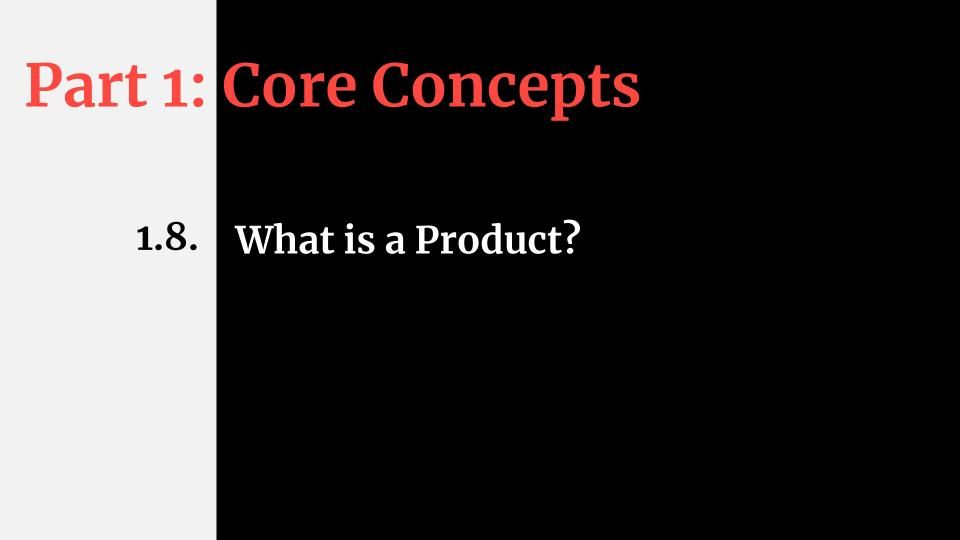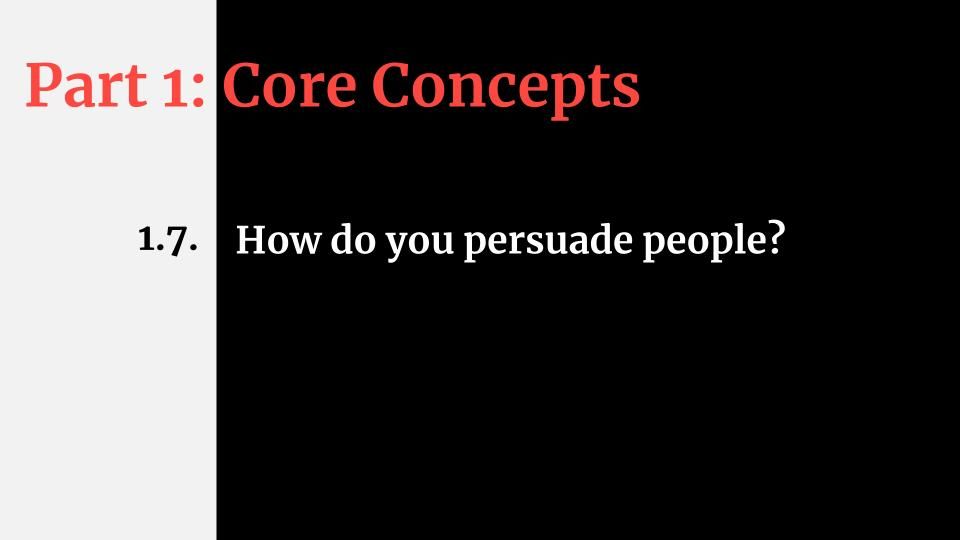1.8. What is a Product?

A product is anything of value that could satisfy a want or need. In other words, a product is the means through which value is delivered to a customer. Any sophisticated business person knows that a product is only successful when customers succeed in achieving their objectives by using it.
In classic marketing and business textbooks, products are often categorized into tangible and intangible. Tangible products, the definition goes, are physical objects that can be perceived by touch. Your smartphone, laptop, and car all fall under the tangible products category. We not only can touch but see, feel, smell, and even taste them.
Intangible products can only be perceived indirectly. Any kind of service falls under intangible products. You can't really see or touch your car insurance. If you are hiring an accountant or a financial planner or you buy an insurance policy you can't see or compare these services. They are abstract. Inherently, services are always intangible.
Usually, by tangible products, we mean physical goods, and by intangible products we mean services.
While it's helpful to understand the basic difference between tangible products and intangible services, in practice the distinction is hardly helpful, useful, or even necessary. We would be hard-pressed to find examples of products today that don't include some kind of service.
Almost every product offering includes service. Even if a company sells commodity products such as oil, metals, or grain it often differentiates with services — how the products are delivered, how responsive their customer service is, and even where their supply comes from and on their corporate ethics (source Marketing Imagination). Every product offering includes service, however not every service has a tangible product to go with it.
Therefore, as marketers, we need to be aware that every company is a service company. Companies can't survive without differentiating themselves and services play a critical role in differentiating companies even in the reddest oceans (highly competitive or commoditized markets). Tesla has service centers. So does Apple, one of the most successful electronics companies in history. Services provide an essential part of a product offering for any company.
Great marketers understand how services are different from products and how they should be created, delivered, and marketed. Marketing services is a challenging task because it is difficult to perceive what the services include.
Products are more standardized and can be scaled more easily than services. Your accountant provides personalized services that can't be reapplied or reused for another client. On the other hand, your smartphone can come in one of a few colors or settings. But the core of your smartphone doesn't change much from one item to another. Products have the advantage of being mass-produced with limited personalization. Services more often than not are made just for you. It means that, unlike tangible products that follow a certain production process, services are more personalized for each customer.
Hence, it is much harder to evaluate the quality of services than the quality of the product. You can compare two cars in terms of size, speed, and economy. But how do you compare the quality of services among accountants or financial planners or hair stylists or marketing consultants? The perceived quality of service is based on customer expectations, customer experience, and the desired outcome the customer wants to reach. And those expectations, experiences, and outcomes are not easily measured.
Differentiating products that don't have tangible elements is hard because we can't use human senses to build a stronger connection between product and consumer. When we see tangible products like cars, computers, or beauty products our senses help us form a perception of them. We can smell, see, touch, hear, and taste tangible products, thus, providing more opportunities to build a connection between those products and our emotional perceptions.
And since service is highly customized and often requires different delivery or implementation processes, the price for services varies greatly. A top attorney in a specific area is constrained by how many hours they can work and how many clients they can take. The only way for a top attorney to grow the practice is to scale through expanding their team or charging higher fees to serve the customer segment with higher needs and deeper pockets. That's why the price for services that promise customers the same outcome can vary in multiples.
Consumers can pay between a few hundred and a few thousand dollars for services that promise the same service. A five-dollar haircut promises the same service as a nine-hundred-dollar haircut from a top Hollywood hairstylist. However, as customers, we expect quite different experiences and outcomes from these services.
Customer expectations are harder to manage in the service business. When you are buying a car you have a better idea of what to expect. At the very least you expect to drive it off the dealership lot with the exact color and model car you test drove. With services, expectations are more abstract and harder to align between seller and buyer. Customer expectations have a direct impact on the overall customer experience. Therefore, customer experience with a service provider is an important factor in evaluating the quality of service.
Since we hear a lot about customer experience it's worth taking a moment to define it.
Customer experience (CX) is a customer's perception of a company, brand, or product, based on all touchpoints, interactions, and engagement that the customer has with the company, its brand, and its product.
The software revolution has blurred the line between products and services even further. Look at any product or company close enough and you’ll find software powering its production, delivery, marketing, or customer service.
Let's take something as simple as ice cream. The ice cream production factory uses the software. Its warehouses are likely to be automated with software. The marketing of ice cream includes digital channels and even if more traditional ways of marketing, such as radio or newspaper advertising, are employed they almost certainly use some software for analysis, optimization, and performance improvement. As Marc Andreessen famously put it, "software is eating the world." There is a software component to almost everything we do today as citizens and consumers. Every company is a software company.
If your organization sells software, unquestionably services are part of the product offering. This idea is also reflected in the term Software-as-a-Service (SaaS). It is safe to assume that every product today includes services offering. Therefore, every marketer and founder should understand the challenges of marketing services. For the sake of simplicity, the terms product, product offering, and service will be used interchangeably in this book and all of them mean a combination of product and service.
In his iconic book, Crossing the Chasm, Geoffrey Moore introduced tech marketers and execs to the technology adoption cycle. The idea is that every new product follows a five-stage adoption process and each stage is represented with a specific customer segment. New product is first acquired by Innovators — technology enthusiasts that want to try, test, and brag about being the first people to use it. Then, a larger group of Early Adopters purchases the product to gain the edge. Next, the Early Majority follows only after the product's true value and benefits have been tested and proven on the market. When a product becomes some sort of an industry-standard then more conservative customers that share the same needs and values as the early majority become customers. This group is called the Late Majority. Lastly, Laggards, the biggest skeptics who are risk-averse, become customers only after the technology becomes so mainstream that using any other option can put them out of business.
The technology adoption curve is presented as a bell curve, where the Early Majority and Late Majority segments meet in the middle and the sum of Innovators and Early Adopters is roughly equal in size to the Laggards.
Moore's technology adoption curve is a variation of the product lifecycle framework, where every product goes through the four product adoption stages: introduction, growth, maturity, and decline. The main idea of Crossing the Chasm is that as companies launch new products, at each stage of the product lifecycle a different type of customer needs to be addressed based on their perception of technology.
But for a couple of important reasons, Moore's technology adoption curve, as well as product lifecycle, are no longer practical frameworks for marketers and founders. The product lifecycle management framework was introduced in the 1980s when products constituted something complete and finished. It was helpful to see sales and marketing through the prism of the product lifecycle in the on-premise software area. At that time, it was more complicated and costly for companies to release updates because often, new releases were treated as a new version of the product requiring a new physical installation of software. Just picture an early version of Windows that had to be updated using a CD, or even a floppy drive.
With SaaS, the product lifecycle concept became obsolete. Today, companies make incremental improvements and release product updates in the cloud on a weekly, daily, and sometimes even hourly basis. This became possible with a new set of technologies and processes called continuous deployment.
When Moore popularized his technology adoption curve, the newly created product didn't change much as it moved through the product lifecycle. The rate of innovation and product deployment has increased so dramatically that no product can be considered static and therefore at any point a new feature can be introduced that solves an important need and moves some potential customers from Laggards to Early Adopters.
Another major issue with the technology adoption curve is that in practice it's almost impossible to segment customers into innovators, early adopters, and so on. It’s much more effective to identify the ideal customer, who understands the problem and is motivated to solve it, than to look for those who might be more open to trying new and unproven products. Furthermore, whether someone is an Early Adopter or a Laggard can fluctuate depending on the industry and customer interests. For example, an individual can be conservative when it comes to buying new cars but at the same time be very open to trying new software at work to find an advantage or a new way of getting ahead.
A marketing playbook where the ideal customer profile is clearly presented will be a more effective, and frankly simplified, marketing strategy than trying to target customer segments according to the technology adoption lifecycle. Also, how do you target Early Adopters in your marketing or GTM strategy? Therefore, focusing on product values and customer needs is a more practical and effective approach.
Product/Market Fit
Everyone in a startup universe is familiar with the term product/market fit created by entrepreneur and investor Marc Andreessen. He provides a simple definition: "Product/market fit means being in a good market with a product that can satisfy that market." Essentially, product/market fit occurs when enough demand exists on the market for a particular product.
Andreessen's definition of product/market fit is awfully similar to Peter Drucker's idea of the purpose of business. Product/market fit describes the process of creating a customer and generating enough demand for sustainable growth. Another interesting observation that’s worth pointing out is that the concept of product/market fit supports the idea that the two primary functions of every business are innovation and marketing. In a product/market fit, a product represents innovation and market refers to marketing. Product/market fit can only be achieved through innovation and marketing.
By cycling through a combination of product and customer, a startup finds product/market fit. Market demand is created by companies. Product/market fit essentially is the process of creating enough customers for a new product to build a profitable business.
Painkillers vs Vitamins
Is your product a painkiller or a vitamin? Painkillers vs vitamins is a popular framework, especially in a startup ecosystem, for understanding how critical your product is to your customers.
Painkillers solve critical and often unmet customer needs. A painkiller is a product that your customers can't go without. Painkillers are products that customers “need to have." You can survive a serious infection without painkillers or antibiotics but it's a much more painful process.
Vitamins improve customers' lives but are not necessarily a must-have. A vitamin is a product that your customer can live without. Vitamins often improve an existing condition.
The conventional wisdom says that companies, and especially startups, should focus on building painkillers and not vitamins. Painkillers address a clear need and problem while vitamins are built to improve lives around less critical values.
For instance, a CRM product for a company is a painkiller. There is hardly any more important software for an organization than a customer relationship management solution. How can you build a successful business without tracking and managing your customers? So, CRM is a crucial system for every sales department. Yet, a product that lets salespeople track important corporate announcements to identify when the timing is right for outreach is a vitamin.
However, this framework might not be as practical as it seems on the surface. For one, not every pain or need is the same. Some pains require medicine, some require hospitalization, but some are mere mild pain that causes slight discomfort. Additionally, the greater the pain, the less likely the patient has done any preventative measures. If you are not taking your vitamins daily it's possible you will wake up with a massive health problem in the future.
Therefore, over time some vitamin-like solutions become more valuable than painkillers. Many of the biggest product successes in the last two decades have been from companies selling vitamins — Facebook, Twitter, Netflix, and others. You can argue that these vitamin-like products became painkillers over time.
While painkillers solve a need, vitamins create a desire. And desire, in many cases, could be a powerful force for customers. A strong desire becomes a need.
A better framework is understanding whether a customer is aware or unaware of the problem. If your target audience is aware of the problem you are trying to solve with your product then it's easier to explain why they need it (painkiller). In contrast, if the problem is unknown to the customer then they have to be educated on why your product is needed (vitamin). A customer education process is expensive and time-consuming. Thus, it's often easier to reach a product/market fit with a product that solves a well-understood problem.
Building 10x Product
The primary idea for the dichotomy between painkillers and vitamins is to explain how challenging it is to bring new products to market. New products have to be 10x better than existing alternatives to reach product/market fit.
Switching costs are high. The status quo is always a safer option. Doing what we have been doing is much easier. And almost every change must overcome the resistance of the people, organizations, processes, and habits. That's why your product must be a few multiples better than the current alternative to gain traction.
But this 10x analogy is often misinterpreted. How can you build a 10x better product than Salesforce, or Stripe, or other mature and well-run organizations? The key is not to focus on the solution that is 10x better for all customers and all use cases. All you need is to focus on a specific segment of the customers or a specific use case that current alternatives are not addressing. It's futile to try to build a 10x better CRM to compete with Salesforce. It's much more effective to focus on building a better CRM for small businesses or for specific markets like healthcare, or manufacturing that have very specific needs that can be underserved by all-in-one solutions.
Checkout my course on How to Conduct Customer Interviews
Read previous chapter


